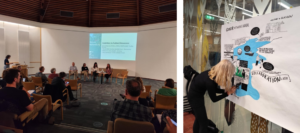Blog
Building Connections: Linking climate adaptation research and practice

How can we make sure that scientific research focuses on real-world climate challenges and provides solutions that are relevant to our communities? That’s the question that I have been trying to answer this summer.
The five weeks I spent in Scotland with Verture was a brilliant learning opportunity and I had several key takeaways:
- Boundary-spanning organisations are essential.
- Building partnerships and collaboration opportunities is about building trust.
- Maintaining partnership working will require long-term and diverse funding models.
- The Arts supports transdisciplinary action and reaches people in a way that science alone can’t.
- Local Action is key.
Creative Climate Futures
One of the core initiatives I got involved in was the Creative Climate Futures Project. This amazing collaboration is a great example of how creativity and the arts have a crucial place in building community connections and bringing climate action to life in a way that involves local people.
I visited projects in both Easterhouse and the Gorbals, meeting with community managers, artists, local councillors, the Verture team and national arts organisations. In Easterhouse I attended an action group meeting at Pavillion, learning more about the work that went into the development of the artwork, helping local groups build momentum and spark further climate conversations.
In the Gorbals I attended one of the most engaging meetings of my placement. Elena, the local artist for the Gorbals, led participants through an exercise that helped everyone reflect on different stages of the project and how the work makes them feel. She later combined these reflections into a poem capturing the shared journey. I also met with staff at the Crossroads Youth and Community Association to learn about the new nature trail created by communities. This trail aims to encourage people to support local green spaces, raise awareness of biodiversity, and create opportunities for citizen-science activities in the future.
Conferences – Nature Scot: Breathing Life into Nature Networks & Coast-R Forum
I attended some events highlighting the variety of work being done in building nature networks and coastal resilience. The Nature Scot: Breathing Life into Nature Networks event, held by NatureScot, was a great opportunity to hear about some of the excellent nature networks and nature restoration activities that that are ongoing across Scotland.
The Coast-R Forum, hosted by the University of Glasgow, focused on working across interfaces to build coastal community resilience to changing land-sea dynamics. Beyond a wide range of workshop activities that inspired innovative ideas for connecting with different stakeholders, the keynote speech from the brilliant Howard Wood, was a particular highlight of this event.

(left) panel discussion at the Nature Scot Conference on Ambition in Action, and (right) the use of artwork to summarise discussions on how we can work together to build resilient coastal communities at the Coast-R Forum
Partnership Working
My time at Verture gave me the opportunity to see how fundamental partnership working is to successful climate adaptation, and to understand the hard work that goes into developing such partnerships day-to-day. Regional Climate Action Partnerships have now been established across much of Scotland. Although they are at very different stages, they all bring a range of stakeholders together to tackle the climate challenge.
I had the opportunity to attend the Climate Ready Infrastructure Scotland Forum, another brilliant example of partnership in action. Participants explored how different approaches to collate action and risk dependencies can shape more resilient infrastructure planning. The forum highlighted the willingness of different organisations to collaborate and take collective responsibility for shared challenges.
Another highlight was meeting Professor Jaime Toney and learning about the GALLANT project led by University of Glasgow. GALLANT trial’s sustainable approaches throughout participatory action research that places communities at the heart of the work. The combination of scientific research with lived experience was clearly essential to the project’s aims.
Verture is responsible for coordinating or supporting many of the climate adaptation partnerships, climate hubs and organisations involved in climate action, connecting national level policy with real-world challenges. Spending time embedded in Verture has allowed me to understand the structures of these partnerships, how and why they were established, and the role of communities in these partnerships.
Author : Denise McCullagh
Climate Resilience Researcher, Impacts and Adaptation Group
MaREI Centre, University College Cork
